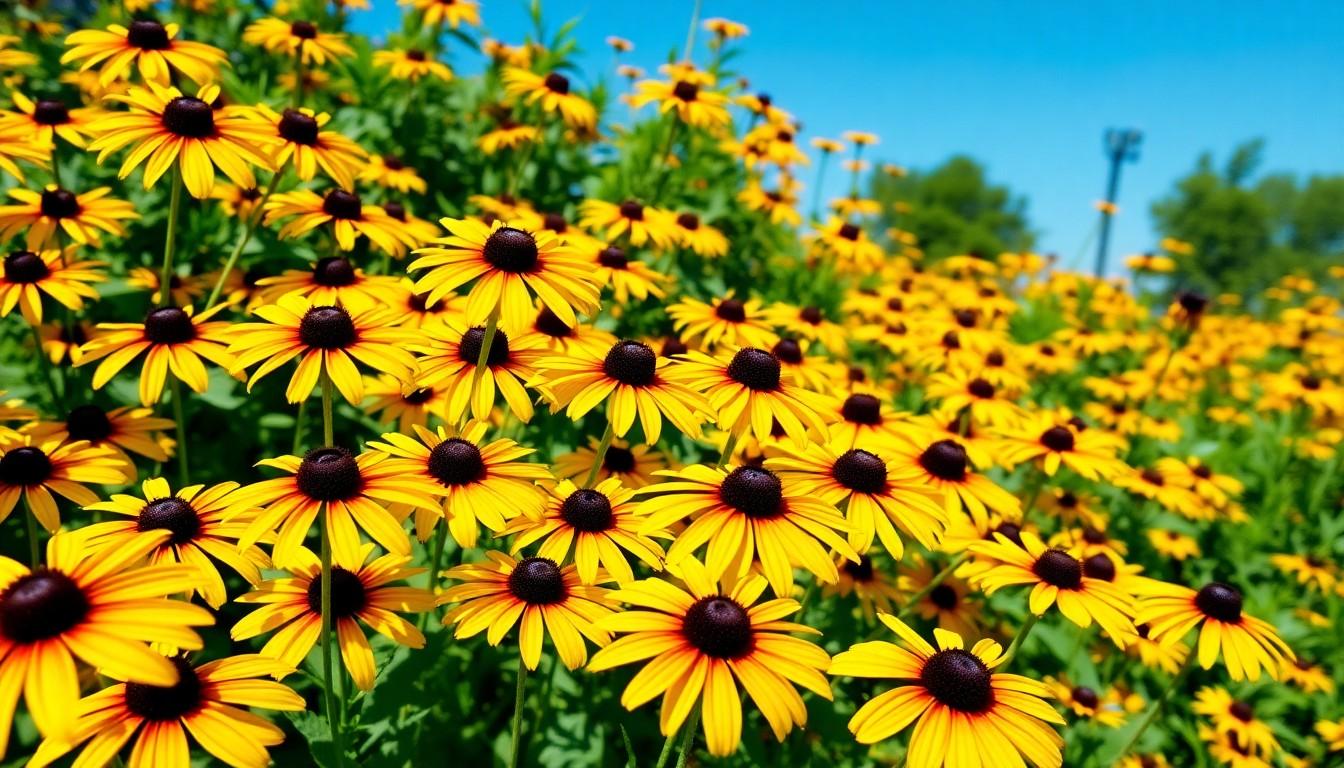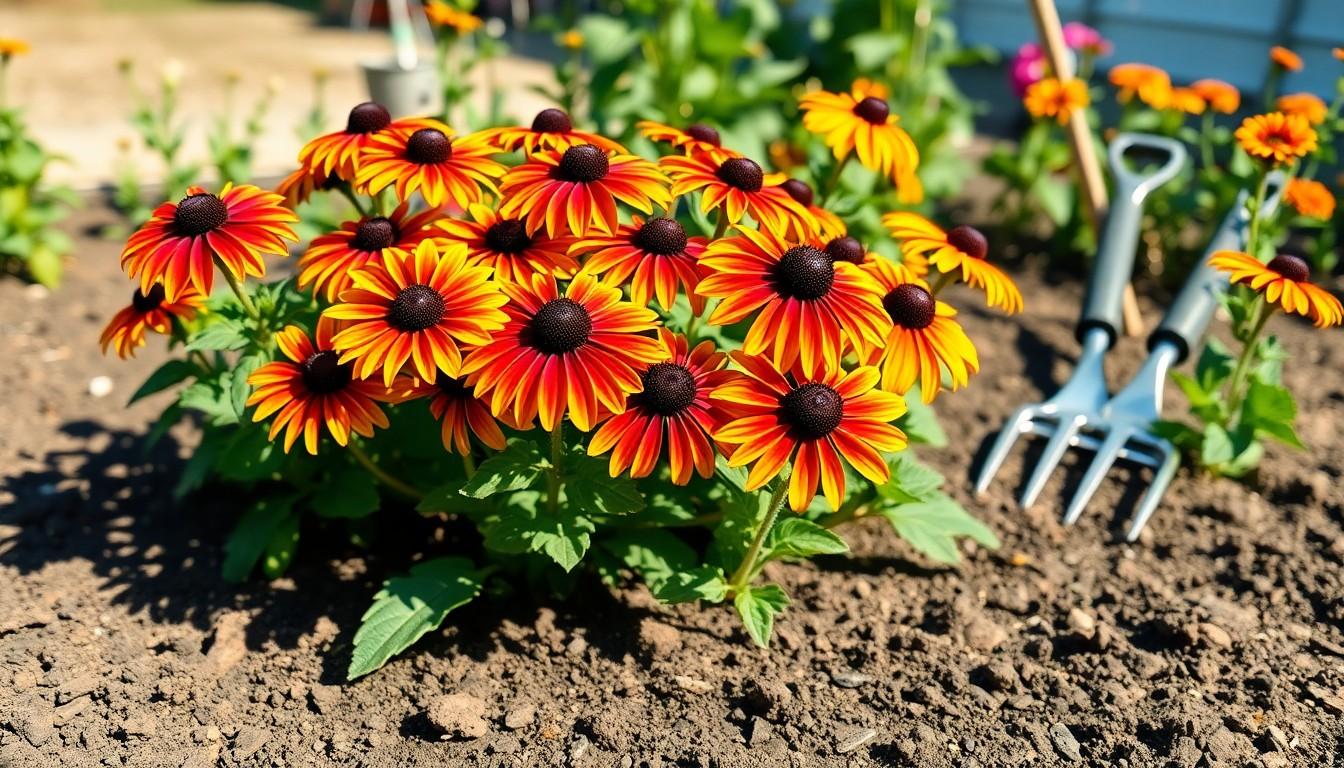Phone:
(701)814-6992
Physical address:
6296 Donnelly Plaza
Ratkeville, Bahamas.

If there’s one flower that can brighten up a garden faster than a toddler on a sugar rush, it’s the Black Eyed Susan. With its cheerful yellow petals and dark centers, this perennial powerhouse is not just a pretty face; it’s also incredibly low-maintenance. But don’t let its laid-back attitude fool you. Even the most carefree blooms need a little TLC to thrive.
Black Eyed Susan (Rudbeckia hirta) features vibrant yellow petals surrounding a dark center. Native to North America, this perennial thrives in various garden settings. It’s often chosen for its resilient nature and long blooming season, lasting from summer to fall.
Maintenance levels remain low, yet some care ensures optimal growth. Planting in well-drained soil with moderate fertility promotes healthy development. Full sun exposure, ideally six to eight hours daily, enhances flowering.
Watering practices are essential; maintaining moisture during dry spells supports vibrant blooms. Fertilizing in early spring encourages robust growth and abundant flowers. Deadheading spent blooms, or removing faded flowers, stimulates further flowering and keeps the plant tidy.
Pests like aphids and diseases such as powdery mildew may occasionally occur. Monitoring for signs of distress helps in applying timely treatments, ensuring plant health. Spacing plants approximately 18 to 24 inches apart allows for airflow, reducing disease risk.
Black Eyed Susan attracts pollinators such as bees and butterflies, contributing positively to the garden ecosystem. For lasting beauty, consider dividing clumps every few years. This practice not only rejuvenates established plants but also creates new ones for different areas of the garden.

Planting Black Eyed Susans requires careful consideration of location and soil conditions for optimal growth.
Selecting a sunny spot ensures healthy blooms. Full sun exposure for six to eight hours promotes vigorous flowering. Well-ventilated areas help reduce disease risk, making it crucial to avoid crowded spaces. Placing plants where they can enjoy warmth enhances their resilience. Although tolerant of various conditions, they thrive best in open, bright environments. Consider nearby structures that may cast shadows later in the day.
Fertile, well-drained soil supports robust Black Eyed Susans. They favor moderately fertile conditions, so testing soil before planting offers valuable insights. Adjusting pH to between 6.0 and 7.0 optimizes nutrient availability. Heavy clay or overly sandy soils hinder growth, so it’s essential to amend with organic matter. Adding compost improves drainage and enriches nutrients. Regularly aerating the soil also encourages root development, promoting overall plant health.
Black Eyed Susans thrive with proper watering and fertilizing practices, ensuring robust growth and vibrant blooms.
Water deeply but infrequently to promote strong root systems. Moisture should be maintained during dry spells, with about one inch of water per week being ideal. Checking the soil’s moisture level before watering helps avoid over-saturation. Early morning is the best time to water, allowing foliage to dry quickly and reducing disease risk. Additionally, using a drip irrigation system can provide consistent moisture while conserving water. Mulching around the plants also aids in retaining soil moisture and regulating temperature.
In early spring, applying a balanced fertilizer supports healthy growth. A 10-10-10 NPK ratio works well, providing the necessary nutrients for blooming. Granular fertilizer can be sprinkled around the base of the plants, followed by watering to help absorption. Organic options like compost or well-rotted manure enrich the soil and boost nutrient content. Avoid excessive fertilization, as it may lead to more foliage but fewer flowers. Regularly monitoring plant health and adjusting fertilization as needed promotes optimal growth.
Maintaining Black Eyed Susans involves monitoring for pests and diseases to ensure vibrant blooms. Awareness of potential threats can enhance plant care.
Aphids frequently target Black Eyed Susans, causing stunt growth. These small green or black insects can be found on stems and leaves. Additionally, spider mites may appear, particularly in dry conditions. Their presence often leads to discolored leaves. Japanese beetles prefer the petals, creating unsightly holes. Keep an eye out for these pests to prevent significant damage. Regular observation and identification can help manage their impact.
Implementing preventive measures minimizes pest risks. Selecting disease-resistant plant varieties boosts resilience against common issues. Offering adequate spacing promotes air circulation, reducing humidity that attracts pests. Regularly inspecting plants for signs of distress allows for early intervention against infestations. Encouraging natural predators, such as ladybugs, can provide additional protection. Furthermore, employing organic insecticides as a last resort maintains a healthy garden ecosystem while addressing pest concerns.
Pruning and maintenance are essential for keeping Black Eyed Susans healthy and vibrant. Timely care promotes robust growth and longevity.
Pruning Black Eyed Susans typically occurs in late winter or early spring. This timing helps remove any dead or damaged stems, encouraging new growth. Consider cutting back the previous year’s foliage to promote airflow and reduce disease risks. Additionally, after the blooming season ends, deadheading spent flowers prevents seed production and supports a longer flowering period. Early intervention ensures the plant remains focused on producing new blooms rather than seeds.
Maintaining healthy growth involves consistent care practices. Regular watering, particularly during dry spells, helps keep the soil evenly moist. Fertilizing in early spring with a balanced 10-10-10 NPK ratio enhances nutrient uptake. Monitor soil moisture closely, aiming for about one inch weekly to avoid stress on the plants. Moreover, mulching aids in moisture retention and weed suppression. Spacing plants 18 to 24 inches apart improves air circulation, reducing the risk of disease. Regular inspections for signs of pests or distress contribute to a thriving garden environment.
Caring for Black Eyed Susans is a rewarding endeavor that brings vibrant color and life to any garden. With their low-maintenance requirements and ability to attract pollinators, these plants are perfect for both novice and experienced gardeners. By ensuring the right soil conditions, adequate sunlight, and regular maintenance, they can thrive and bloom beautifully throughout the growing season.
Staying vigilant against pests and diseases will help maintain their health and vigor. With proper care, Black Eyed Susans will not only enhance the garden’s aesthetic but also contribute to a rich ecosystem. Embracing these practices will lead to a flourishing display of these stunning flowers year after year.